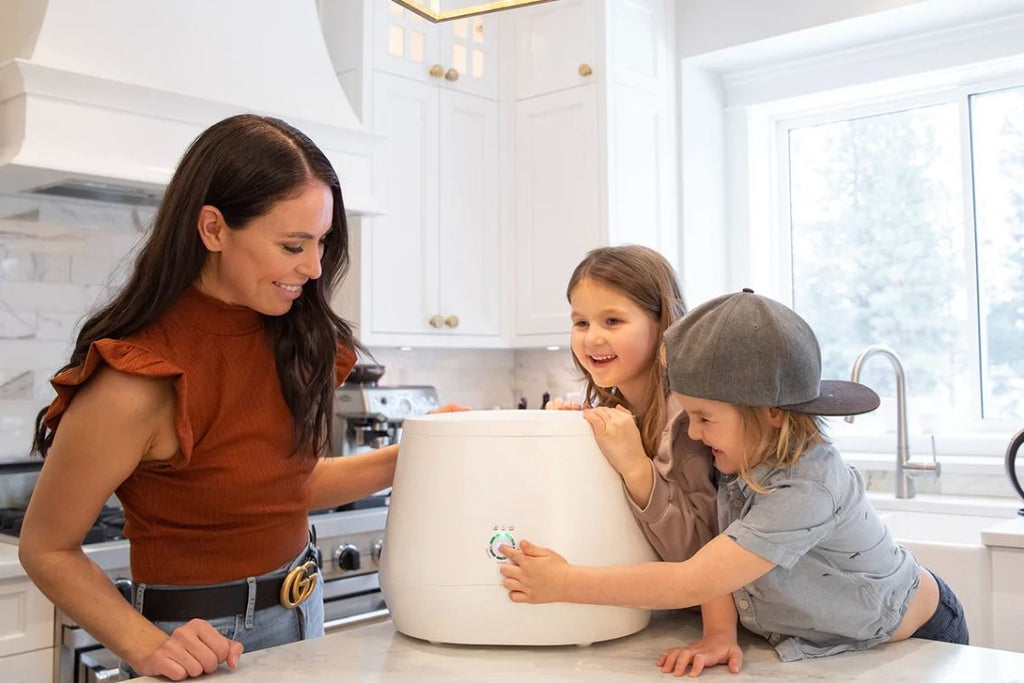
Sustainable living is essential for the future of our planet, and it's important for us all to take the steps we can to be more eco-friendly. One amazing way to reduce is by composting at home. You'll be diverting food waste from landfills, therefore preventing carbon emissions and other negative environmental impacts.
Of course, home composting can be a little more work than investing in an eco-friendly phone case. Traditional composting methods often require lots of space, time, and know-how to get done right. It doesn't have to be hard, though. In fact, compost machines make home composting super simple. So, let's take a quick look at what composter machines are, why you might want one, and which one you should get.
Table of contents
Let's start by learning what composter machines even are.
What is a compost machine?

A compost machine is essentially a compost bin that uses electricity to speed up the natural composting process. Because of the energy use, you can expect finished results anywhere from just a few hours to a week, depending on the machine. While this isn't as eco-friendly as an outdoor compost pile, it is easy and accessible.
Composter machines are becoming more and more popular because they're so easy to use, and because you don't need any outdoor space whatsoever to use them. Because of that, they're making home composting a simple process that anyone can do. With most machines, all you need to do is fill them up, adjust the settings to what you want, and push a button. After that, you just need to wait for it to finish.
Composting machine vs other home composting methods

Traditional composting and machine composting are actually pretty similar because a composter machine goes through the regular composting process at a quicker pace. The major differences between the two are what's important for you: The effort you put into it, the energy needed, and the finished compost.
Let's take a look at effort first. The variety of traditional composting methods ranges in how much time and energy you need to put into it, from very little to regular maintenance. However, there's always going to be some amount of work you need to put in. That's just not the case with machine composting. All you need to do is fill the bucket and push the button. You don't even need to understand how composting works, which you do need to know if you want a traditional composter.
Of course, the next thing we need to talk about is energy. A composter machine will always require electricity, while traditional composting just doesn't. How sustainable that is will depend on where you get your electricity and how energy-efficient the electric composters are. However, using a small amount of electricity to eliminate food waste will always be better than sending your kitchen scraps off to a landfill.
The finished product you get from regular composting and electric composting are also a bit different because of how quickly composter machines work. However, both the finished compost you get from traditional methods and the natural fertilizer you get from machine composting are great additives for your gardens and indoor plants.
|
Pros |
Cons |
|
|
Composter machine |
|
|
|
Home composting |
|
|
NOTE: Keep in mind that there is a difference in quality between composter machines. For example, Lomi creates a high-quality nutrient-rich dirt you can immediately add to your garden, while many other composter machines create nothing more than dehydrated and ground food waste you wouldn't want to try to feed your plants. Lomi is also able to create natural fertilizer quickly compared to other machines, as Lomi completes its Grow mode cycle in less than a day, while other machines can take multiple days to finish.

5 best home composter machines currently available
If you're convinced that a composting machine is right for you, you'll need to know which one to buy. Here are the top 5 composer machines currently on the market.
1. Lomi

The Lomi compost machine is always going to be a fantastic choice. It was developed by Pela, one of the world's leading sustainability brands and the creators of Pela case. Pela designed Lomi with the purpose of meeting its company mission: to eliminate the world's waste. With this purpose in mind, Lomi also arrives at your door certified Climate Neutral. There's no point in trying to help the earth if it's getting harmed in the process.
As a product, Lomi is also a high-quality choice for electric composters. Lomi is effective, easy to use, and even a stylish addition to your kitchen. If your focus is on sustainability as a whole, Lomi is also an energy-efficient option. The end product Lomi creates is also top-quality. With the use of Lomi pods, beneficial microbes are added to your food waste that you would normally get when composting. This results in a nutrient-rich and microbe-rich dirt that is perfect for any garden.
Unlike other electric composters, Lomi also provides you with three different modes you can choose from:
- Eco-Express: This is Lomi's shortest mode, finishing in 3-5 hours. It's also the most energy-efficient mode.
- Lomi Approved: This mode takes 5-8 hours to complete, and is the mode you'll choose if you want to break down Lomi approved bioplastics.
- Grow: Although it's the longest mode at 16-20 hours to complete, Grow mode is the one you'll want to choose if you're looking for high-quality natural fertilizer.
Another feature unique to Lomi is its ability to break down Lomi approved bioplastics. This includes Lomi's own packaging as well as Pela cases. Bioplastics cannot be composted at home in any other way, and would normally need to get sent to industrial composting facilities, if your municipality even has one. If you're a fan of bioplastics, the only way to break some down at home is with Lomi.
| What we like | What we don’t like |
|
|
2. Vitamix FoodCyler

You're probably already comfortable with the Vitamix brand, as they're a trusted brand name for kitchen blenders. However, a quality composter machine is very different from a blender, and you shouldn't necessarily trust that the Vitamix FoodCycler FC 50 is the best you'll get because your Vitamix blender is amazing.
At the end of the day, the FoodCycler is okay. It breaks down food waste, but it doesn't turn it into anything much more than dehydrated and chopped-up kitchen waste. This is because, unlike Lomi, the FoodCycler doesn't add beneficial microorganisms to the food scraps. You wouldn't want to try adding that to your plants without further composting it first. Of course, if your only aim is to reduce your food waste, then the FoodCycler does a fine job of that.
The FoodCycler is also cheaper than most composter machines, making it more accessible. However, that also comes with a smaller capacity and some durability issues. While this may be cheaper up front, it may not be worth the risk, especially considering they don't offer a money-back guarantee trial period.
|
What we like |
What we don’t like |
|
|
Are you interested in seeing how the Vitamix FoodCycler compares to Lomi? You can check out this detailed comparison we've written on the FoodCycler vs Lomi.
3. Tero

Another popular option is the Tero, which works similarly to the Vitamix FoodCycler, with just a few differences. First, an important detail they have in common is that Tero doesn't introduce helpful microbes while it's working, so it produces low-quality dirt similar to the FoodCycler's.
However, it does also offer a couple of improvements. The first is its large capacity. At 4L, you won't need to worry about it being able to handle your food waste. The other difference is that it has a refillable carbon filter instead of a replaceable one. Replaceable carbon filters end up creating waste of their own. By making them refillable, Tero is able to prevent more waste.
However, Tero is a more expensive option. While the standard price is similar to Lomi's, this only gets you the bare-bones version of Tero. If you want all its features and capabilities, you need to spend an extra $100 for the Tero Plus version. Another concern is its reviews - not only are they lackluster, but they're coming from a limited pool of users who were already able to try the Tero. It's important to keep in mind that Tero hasn't actually been shipped yet, and you can only preorder the product right now.
|
What we like |
What we don’t like |
|
|
To learn more about how Tero compares to Lomi, you can take a look at this in-depth article we wrote about the differences between Tero and Lomi.
4. Reencle

A newer option on the market is Reencle. Unlike the other 3 electric composters we've looked at so far, this composter machine doesn't sit on your countertop. Instead, Reencle is designed to sit on your floor in your home somewhere, and even has a touchless opening installed so you can easily open it with your foot.
Despite its larger size, its capacity for food scraps per day is actually the same as Lomi's. One big difference, though, is that it's constantly running. This means that you can open it and add waste to it even while it's turned on. You can also scoop out finished dirt whenever you want. Of course, that does mean you'll have to sift food waste out of the finished product whenever you want some.
It's also important to note that Reencle is quite expensive and a risky purchase. There's no risk-free or money-back guarantee period with your purchase, so you need to hope it actually works well. It's also hard to trust the reviews for this one. Their website claims they have 4.9/5 star ratings from over 100,000 reviews. But, there's nowhere to find any of those reviews, and they haven't even sold that many units.
|
What we like |
What we don’t like |
|
|
Are you curious about how Reencle differs from Lomi? Check out our thorough comparison of Lomi and Reencle.
5. Kalea

Another standing composter machine is Kalea, which also functions a bit more like Reencle than the other compost machines. Much like Reencle, food waste can be added to Kalea at any point, even while it's working. However, with Kalea, the kitchen waste goes through vertical stages so that the finished dirt ends up at the bottom, already separated from the food scraps. This makes retrieval far easier than with Reencle.
Kalea also has a much larger food waste capacity than any of the other electric composters on this list, as it can hold up to 10L of waste. However, this does come with a downside of a much longer cycle length of 48 hours, which is the longest cycle length of compost machines on this list. As there are also no microbial add-ins, the finished product at the end of those 48 hours is a low-quality soil amendment.
Kalea is another expensive compost machine, as well. Because there's no money-back trial and there aren't any ratings available for this product, it's also a risky purchase. Unlike Lomi, Kalea also doesn't offer free shipping, making it even more expensive.
|
What we like |
What we don’t like |
|
|
Check out this detailed comparison of Lomi and Kalea to learn more about which one would be best for you.
Compost machines are a convenient and helpful tool for reducing food waste in our homes. In Lomi's case, it can also help reduce bioplastic waste you wouldn't otherwise be able to deal with. If a compost machine is right for you, you can easily order Lomi online. And don't forget to compost your Pela case with Lomi at the end of its life!
Written by: Sereana Simpson



